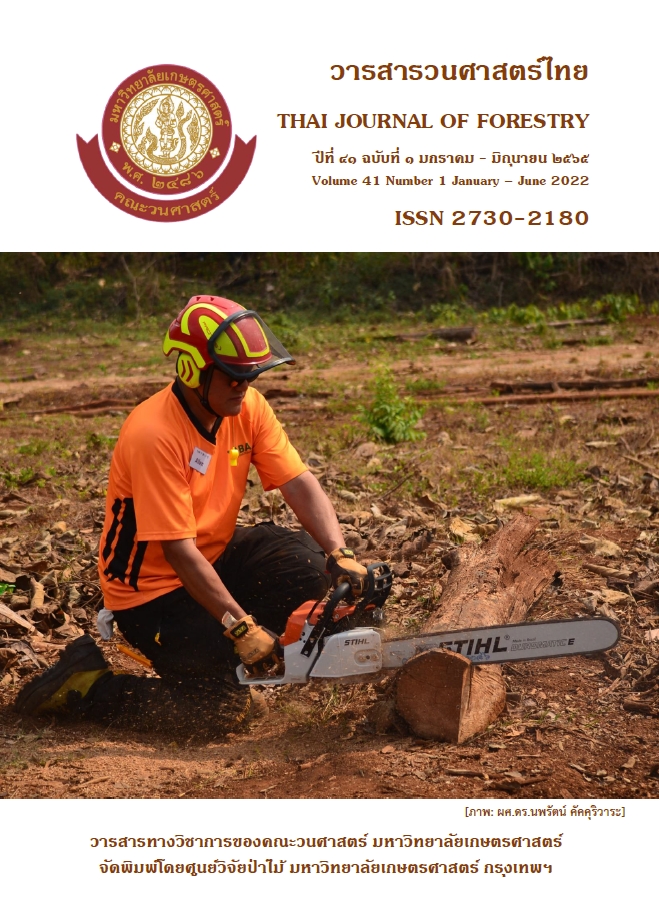คุณสมบัติทางฟิสิกส์และทางกลของไม้ยูคาลิปตัสสายต้น K7
Main Article Content
บทคัดย่อ
ยูคาลิปตัสจัดได้ว่าเป็นไม้เชิงเศรษฐกิจชนิดหนึ่งของประเทศไทย เป็นวัตถุดิบที่สำคัญของอุตสากรรมไม้ต่างๆ แต่การใช้ประโยชน์ในลักษณะเป็นไม้แปรรูปยังมีอยู่จำกัด เนื่องจากขาดแคลนข้อมูลพื้นฐาน ไม้ยูคาลิปตัสสายต้น K7 มีการปลูกอย่างกว้างขวางและมีการเจริญเติบโตอย่างรวดเร็ว วัตถุประสงค์ของการวิจัยนี้ เพื่อศึกษาคุณสมบัติทางฟิสิกส์และทางกลของไม้ยูคาลิปตัสสายต้น K7 เพื่อเป็นข้อมูลพื้นฐานในการนำไปใช้ประโยชน์ในลักษณะไม้แปรรูป คุณสมบัติทางฟิสิกส์ของไม้ยูคาลิปตัสสายต้น K7 ได้แก่ ค่าความถ่วงจำเพาะที่สภาวะอบแห้งมีค่าเฉลี่ยเท่ากับ 0.52 จุดหมาด มีค่าเฉลี่ยอยู่ระหว่าง 26 ถึง 28 เปอร์เซ็นต์ การหดตัวสูงสุดทางด้านสัมผัส ทางด้านรัศมี และการหดตัวทางด้านความยาว มีค่าเท่ากับ 11.00, 7.00 และ 0.65 เปอร์เซ็นต์ ตามลำดับ เมื่อความชื้นลดลงจากจุดหมาดจนถึงความชื้น 0 เปอร์เซ็นต์ และการคายน้ำที่อุณหภูมิคงที่ ค่าคุณสมบัติทางกล ได้แก่ ค่าโมดูลัสแตกหักมีค่าเท่ากับ 72.45 เมกะปาสคาล ค่าโมดูลัสหยืดหยุ่นมีค่าเท่ากับ 6,654 เมกะปาสคาล แรงอัดขนานเสี้ยน มีค่าเท่ากับ 41.94 เมกะปาสคาล แรงอัดตั้งฉากเสี้ยน มีค่าเท่ากับ 5.33 เมกะปาสคาล ค่าความแข็ง มีค่าเท่ากับ 3,075 นิวตัน แรงฉีก และ แรงยึดเหนี่ยวตะปู (nail holding) มีค่าเท่ากับ 2.00 และ 17.91 นิวตันต่อมิลลิเมตร ตามลำดับ จากการเปรียบเทียบคุณสมบัติทางกลกับมาตราฐานไม้ที่ใช้ทำโครงสร้าง พบว่า ไม้ยูคาลิปตัสสายต้น K7 ไม่เหมาะสมทำโครงสร้างหลักของอาคาร ดังนั้นการใช้ประโยชน์ไม้ยูคาลิปตัสสายต้น K7 สามารถนำไปทำ เครื่องเรือน ไม้ค้ำยัน ไม้พื้น ที่รองของ ทำชิ้นไม้สับสำหรับอุตสาหกรรมเยื่อกระดาษ อุตสาหกรรมไม้ประกอบ ฟืนและถ่าน
Downloads
Article Details

อนุญาตภายใต้เงื่อนไข Creative Commons Attribution-NonCommercial-NoDerivatives 4.0 International License.
ข้าพเจ้าและผู้เขียนร่วม (ถ้ามี) ขอรับรองว่า ต้นฉบับที่เสนอมานี้ยังไม่เคยได้รับการตีพิมพ์และไม่ได้อยู่ในระหว่างกระบวนการพิจารณาตีพิมพ์ลงในวารสารหรือสิ่งตีพิมพ์อื่นใด ข้าพเจ้าและผู้เขียนร่วม (ถ้ามี) ยอมรับหลักเกณฑ์และเงื่อนไขการพิจารณาต้นฉบับ ทั้งยินยอมให้กองบรรณาธิการมีสิทธิ์พิจารณาและตรวจแก้ต้นฉบับได้ตามที่เห็นสมควร พร้อมนี้ขอมอบลิขสิทธิ์ผลงานที่ได้รับการตีพิมพ์ให้แก่วารสารวนศาสตร์ คณะวนศาสตร์ มหาวิทยาลัยเกษตรศาสตร์ กรณีมีการฟ้องร้องเรื่องการละเมิดลิขสิทธิ์เกี่ยวกับภาพ กราฟ ข้อความส่วนใดส่วนหนึ่ง หรือ ข้อคิดเห็นที่ปรากฏในผลงาน ให้เป็นความรับผิดชอบของข้าพเจ้าและผู้เขียนร่วม (ถ้ามี) แต่เพียงฝ่ายเดียว และหากข้าพเจ้าและผู้เขียนร่วม (ถ้ามี) ประสงค์ถอนบทความในระหว่างกระบวนการพิจารณาของทางวารสาร ข้าพเจ้าและผู้เขียนร่วม (ถ้ามี) ยินดีรับผิดชอบค่าใช้จ่ายทั้งหมดที่เกิดขึ้นในกระบวนการพิจารณาบทความนั้น”
เอกสารอ้างอิง
American Society for Testing and Materials (ASTM). 2007. D 143. Standard Methods of Testing Small Clear Specimens of Timber.
Aurapeepattanapong, C., Latcharoj, S. 1985. Trend of Wood Utilization and Marketing. Seminar report of Eucalyptus Camaldulensis on 30th October - 1st November 1984. Royal Forest Department. Bangkok. pp. 258-282 (in Thai)
British Standard (BS). 1985. BS 373 Method of Testing Small Clear Specimens of Timber. British Standards Institution.
Building Control Bureau. 2021. Specification Standard of Materials Using in Building Structure. Department of Public Works and Town & Country Planning. Ministry of Interior. (in Thai)
Chafe, S.C. 1990. Effect of brief presteaming on shrinkage, collapse and other wood-water relationships in Eucalyptus regnans E Mull. Wood Science and Technology 24: 311-326
Chomchan, A., Wisuttapekul, S. 1984. Utilized Properties of Eucalyptus camaldulensis in form of Sawn Lumber. Seminar of Eucalyptus Camaldulensis. Royal Forest Department. Bangkok. 254 p. (in Thai)
Chomchan, A., Panyatanya, W. 1985. Eucalyptus and Charcoal. Seminar report of Eucalyptus Camaldulensis on 30th October - 1st November 1984. Royal Forest Department. Bangkok. 249-257 (in Thai)
Dadswell, H.E. 1972. The Anatomy of Eucalyptus Woods. Forest Products Laboratory, Division of Applied Chemistry Technological Paper No. 66. Commonwealth Scientific and Industrial Research Organization, Australia.
Department of Agriculture. 2005. Registration for Plant Varieties Certificate follow Plant Varieties Act 1975. Office of the Council of State. (in Thai)
De Villiers, A.M. 1973. Utilization Problems with some Eucalypts in South Africa. Proceedings, IUFRO Div. 5, Cape Town and Pretoria, South Africa. Pp. 238-255.
Dillner, B., Ljunger, A., Herud, O.A., Thune-Larsen, E. 1970. The breeding of Eucarlyptus globulus on the basis of wood density, chemical composition and growth rate. In The Production and Industrial Utilisation of Eucalyptus Symposium in Lisbon, Supplement 5 to Volume XXIII ‘Timber Bulletin for Europe”, pp. 120-155, (FAO:Rome)
Elliott, C.S. 1967. Utilization of Eucalyptus wood. In World symposium of Man-made Forests and their Industrial Importance. Vol. I., FAO: Rome. pp. 823-844.
Forest Products Development Division. 2010. General Characteristics of Thai Timbers. Forest Research and Development Bureau. Royal Forest Department. Bangkok. (in Thai)
Hanvongjirawat, W. 2016. Physical and mechanical properties of Eucalyptus urophylla clone K58. Thai Journal of Forestry 35(3): 128-135.
Ilic, J. 1999. Shrinkage related degrade and its association with some physical properties in Eucalyptus regnans F. Muell. Wood Science and Technology 33: 425-437.
Malan, F.S. 1984. Studies on the Phenotypic Variation in Growth Stress Intensity and its Association with Tree and Wood Properties of South African Grown Eucalyptus grandis (Hill ex Maiden). Dissertation. University of Stellenbosch
Malan, F.S. 1993. The wood properties and qualities of three South African grown Eucalypt hybrids. South African Forestry Journal 167(1): 35-44.
Malan, F.S. 2003. The wood quality of the South African timber for high value solid wood products and its role in sustainable forestry. South African Forestry Journal 198(1): 53-62.
Nacar, M., Hiziroglu, S., Kalaycioglu, H. 2005. Some of the properties of particleboard panels made from eucalyptus. American Journal of Applied Sciences (Special Issue): 5-8.
Orwa C, Mutua, A, Kindt, R, Jamnadass R, Anthony, S. 2009. Agroforestree Database: A Tree Reference and Selection Guide Version 4.0 https://www.worldagroforestry.org/publication/agroforestree-database-tree-reference-and-selection-guide-version-40. April 30, 2022.
Palipane, K.B, Driscoll, R.H. 1992. Moisture sorption characteristics of inshell macadamia nuts. Journal of Food Engineering 18(1): 63–76.
Panshin, A.J., de Zeeuw, C. 1980. Textbook of Wood Technology 4th ed. Mc Graw-Hill New York.
Rattiwanich, T., Apichattabutch, A. Namprasert, P. 1987. Sulfate Pulp from Eucalyptus camaldulensis. Forest Products Division. Royal Forest Department. Bangkok. (in Thai)
Riyaphan, J. 2013. Chemical and Mechanical Properties of Wood in Seven Para Rubber (Hevea brasiliensis Muell. Arg.) Clones. M.S. thesis, Faculty of Forestry, Kasetsart University. Bangkok, Thailand. (in Thai)
Royal Forest Department. 2001. Eucalyptus Camaldulensis. Bangkok. (in Thai)
Royal Forest Department. 2020. Forestry Statistics Data. Bangkok. (in Thai)
Vermaas, H.F., Bariska, M. 1994. Collapse during low temperature drying of Eucalyptus grandis W. Hill and Pinus silvestris L. In Proceedings IUFRO Wood Drying Conference. Rotorua. New Zealand, pp.141-150.
Venin, T., Apinantam, S., Wongsiri, A. 1990. Natural Durability of Some Woods. Forestry Conference. Royal Forest Department. pp. 197-220. (in Thai)
Wessels, C.B., Crafford, P.L., Du Toit, B., Grahn, T., Johansson, M., Lundqvist, S.O., Säll, H., Seifert, T. 2016. Variation in physical and mechanical properties from tree drought tolerant Eucalyptus species grown on the dry west coast of Southern Africa. European Journal
of Wood and Wood Products 74(4): 563-575.
Wisuttapekul, S., Fuangwiwat, W., Sukwatnitjakul, S. 1997. Density, shrinkage and fiber saturation point of swamp forest wood. Thai Journal of Forestry 16(1-2): 90-98. (in Thai)
Saneg-ah-tit, S. n.d. Materials testing. Major of Civil Engineering Institute of Engineering. Suranaree University of Technology. Available source: http://www.baannatura.com/public/files/Mpa.pdf. Feb 12, 2015. (in Thai)
Siau, J.F. 1984. Transport Processes in Wood. Springer-Verlag Berlin Heidelberg New York, Tokyo.
Skaar, C. 1972. Water in Wood. Syracue Univ Press, Syracue.
Sompoch, n.d. The Properties of Eucalyptus urophylla S.T. Blake. Institute of Forest Research and Development. Royal Forest Department. Bangkok. (in Thai)
Thaipetch, S. 1985. The Properties of Eucalyptus camaldulensis and Utilizations. Seminar report of Eucalyptus Camaldulensis on 30th October - 1st November 1984. Royal Forest Department. Bangkok, pp. 222-224. (in Thai)
Thaipetch, S., Julruek, S. 1985. The Properties of Eucalyptus camaldulensis. Forestry conference. Royal Forest Department. Bangkok. (in Thai)


